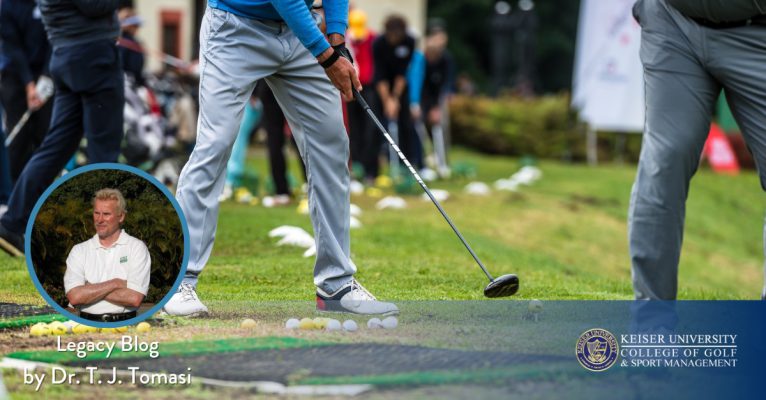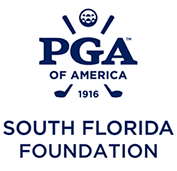A Good Rehearsal Swing Boosts Your Golf Game

by Dr. T.J. Tomasi A Legacy Post by Keiser University College of Golf Senior Faculty and Director of Research (1940-2023)
Tiger Woods knows how important it is to make a perfect practice swing: ‘Practice swings,’ he says, ‘help reinforce my swing keys and promote good swing thoughts. Rehearsal swings have helped me with one of my main goals while I play, i.e., to fully commit to every swing.’
‘If you make a cursory practice swing without full commitment, it’s a wasted motion. I see the same thing among my amateur playing partners in the pro-ams. I also see players make practice swings that don’t fit the intended shot. That’s a real waste of time and energy.’
Golf Practice Swing
Before preparing a shot or teeing, take a practice swing to warm up your swing mechanics. A practice swing is designed to simulate the actual swing before hitting the ball to increase shot performance. Practicing helps you get a feel for the club and prepare your grip, stance, and alignment. The practice swing allows you to gauge the speed and rhythm the shot requires. Visualizing the ball flight can improve focus and confidence going into the shot. Overall, the practice swing is a crucial part of a golfer’s routine for achieving consistency and accuracy.
Before preparing a shot or teeing, take a practice swing to warm up your swing mechanics. A practice swing is designed to simulate the actual swing before hitting the ball to increase shot performance. Practicing helps you get a feel for the club and prepare your grip, stance, and alignment. The practice swing allows you to gauge the speed and rhythm the shot requires. Visualizing the ball flight can improve focus and confidence going into the shot. Overall, the practice swing is a crucial part of a golfer’s routine for achieving consistency and accuracy.
Importance of A Practice Swing in Golf
Practice swings can be more effective when you have a clear and specific goal in mind. Practice swings are an important step in many golfers’ pre-swing ritual. Along with acclimating to your club and visualizing your shot, here are some more goals or benefits of practice swings:
- Build Muscle Memory: Repeating your swing motion reinforces muscle memory, allowing you to replicate a consistent swing.
- Improves Confidence: A well-executed practice swing can help you feel more prepared and focused.
- Swing Speed and Rhythm: Practice swings help you gauge your swing speed and rhythm, allowing you to increase your control and accuracy.
- Improve Ball Contact: Allows you to focus on making clean contact with the ball.
- Adapt to Course Conditions: You can adjust to the specific conditions of the course, such as the lie of the ball, turf, or wind direction.
- Shot Shape: Prepare for a specific shot shape you intend to hit: draw, fade, or straight shot.
- Promote a Smooth Transition: Practice swings offer a smooth transition from the backswing to the downswing, leading to more fluid shots.
Pre-Swing Routine in Golf
Another aspect that can assist your practice swing is a pre-swing routine. There are 3 components to a pre-swing routine that help step up your practice swing and, in turn, your actual shot. Your grip, alignment or posture and setup in your stance all contribute to how a practice shot and real shot are executed. Watch Brian Hughes, a PGA faculty member at Keiser College of Golf, break down the pre-swing routine.
Golf’s GPS
There are two reasons Tiger is correct. The first is the “GPS” trace. Located throughout your body are tiny sensors that make up the golfer’s proprioception system (GPS). The sensors report to your brain what is going on in their district — what the joints are doing, what’s happening in the stretch receptors in the muscles, how much force is being applied as you hold your golf posture, etc. Your brain needs this information to make a coordinated swing. Even though most of your proprioceptive adjustments are unconscious, you can train this super-sense through a practice routine that installs it in your motor memory. You can promote the proper use of your GPS by using rehearsal swings, one of the simplest intervention strategies. This practice motion improves your movement intelligence by using the proprioceptive trace, an after-effect that lingers in your sense memory.
Swinging a weighted club leaves a trace in your sensory tracking system that makes your driver feel incredibly light. Likewise, when you make a perfect practice swing, that trace will remain long enough to cue up your real swing.
Brain security
The second reason Tiger is right on about the efficacy of practice swings has to do with your brain’s warning center. Your golfer’s brain goes on scan while you play, as it looks for assurances that everything is OK, i.e., all the challenges are being managed. The brain’s safety center is located in the amygdala, a walnut-sized piece of tissue designed to warn your brain when a threat/error is detected. It provides full-time security before and after the swing, but it also monitors during the swing using swing keys you have installed through practice. In addition to their other functions, swing keys provide notice to the amygdala that the swing plan is progressing as programmed. Basically, you want the amygdala to monitor your swing keys as proof that your plan is unfolding correctly. When this is the case, there is no alarm and therefore no need for compensations.
Takeaway
Both swing keys and rehearsal swings provide a valuable service by promoting commitment before, during, and after the swing. When you play golf with a calm amygdala, it makes golf seem so easy.

A good warmup programs the brain for the upcoming challenges.
Learn more!
Want more tips? If you want to take your game to the next level, contact our team at Keiser University’s College of Golf & Sport Management today. With our dedication and experience, we can elevate your game to new heights together. Give us a call today at 888-355-4465.














